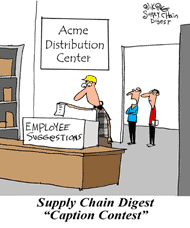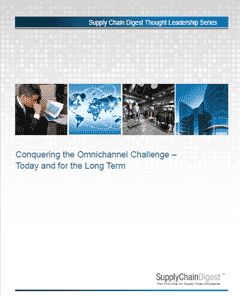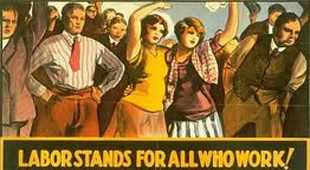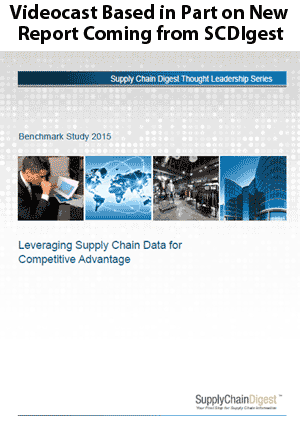 |
September 3, 2015 - Supply Chain Flagship Newsletter |
 |
| FEATURED SPONSOR: AMBER ROAD |
||
 |
||
Aberdeen Research Highlights the Journey to Best-in-Class S&OP |
 |
|
|||||||||||||||||||||||||||||||||||||||||||||||||||||||||||||||||||||||||||||||||||||||||||||
That description of the state of US labor is an interesting one, and largely true based on the data. Yet, as weak as the labor movement has seemingly become in the last few years, there are without question some counter trends. It's clear the last strongholds of unions in the US is in local police and fire and teachers, with about 42% of local government employees in unions, mostly those in those three occupations. After a surprise small jump in the percent of manufacturing workers that are unionized in 2013, to 11%, that number took a rather large drop of 0.5 percentage point in 2014 to just 10.5%, continuing the long terms trend. Think about that - just one in 10 manufacturing workers are unionized today, versus 17.5% in 1994 and, according to uniopnstats.com, 38% of private sector manufacturing workers in 1973. Wow. Don't think this downward union trend is only a US phenomenon. Unionization rates in labor-loving Sweden, for example, have fallen from about 90% in the mid-1990s to more like 70% today. Many other countries mirror more closely the US. Union rates in France - generally considered very supportive of labor - almost exactly follow the US patterns, and are actually just below the US in the percent of all workers unionized. Union membership is higher in the UK, at about 25%, but that's down from more like 40% in the mid-1990s. That obviously puts downward pressure on wages, as the demand for workers is simply much lower than the supply, though the lack of wage growth isn't nearly as bad as I would have guessed, based on all the media reports. According to the BLS, the average hourly wage for shop floor manufacturing workers was about $19.95 per hour in July. That's up from the $16.58 or so per hour in July 2005, or a rise of 20.3% over 10 years. So wages have risen modestly, but not enough to keep up with inflation, let alone improve a worker's lifestyle. OK, those are some of the key facts. Now let's look at some of the key events and trends relative to labor over the past year. There was once again one major symbolic union showdown this year, the attempt to organize Boeing factory workers at its relatively new aircraft plant in South Carolina. In 2014, the major event was a negative vote on unionizing a Volkswagen plant in Tennessee, and in 2013 it was a long strike at a Caterpillar plant in Joliet, IL, which ended with the machinists union basically capitulating to the company's offer. Both events at the time were called "labor's last stand" by some. This year, the major event also went against labor, with the union giving up efforts in April to organize the Boeing plant without a vote.
Also in the negative column for labor, in March Wisconsin became the 25th right to work state, joining Michigan and before that Indiana in recent years, all seen as big losses for labor.
While those two events and overall trends continues to go against labor, that doesn't tell the whole story of the past year by any means.
After very contentious negotiations over many months, a deal was finally reached in late February between West coast ports and the Longshoremen that appeared to give the union almost everything it wanted, including maintenance of its no-cost "Cadillac" healthcare plan that will cost ports and terminals tens of millions annually. A definite labor win here, as usual.
Next up are contract negotiations between US steel makers and their workers, which appear likely to be contentious, with steel makers hurting from big drops in market prices and union leaders digging in against any notion of givebacks. I expect a strike, with the contract having expired earlier this week.
Along the same lines, Walmart earlier this year announced plans to hike its minimum pay first to $9 per hour and then $10 next year, along with also increasing supervisory pay and giving employees more set hours (which I very much support). Saying it was "the right thing to do," Walmart also cited rising labor costs as key factor in its recent Q2 earnings decline. Will we be seeing another wage at Walmart for 2017? I would bet No, but it's hard to say where this minimum wage thing will really go.
But it was the National Labor Relations Board (NLRB) that gave labor its best reasons for optimism in 2015 and beyond.
I do not believe this change has greatly impacted the labor dynamic yet. Will it? Seems like it could, but maybe the concern by employers is overblown.
This could be a real Pandora's box, and business needs to keep close tabs on the coming legal actions and activities within their own businesses based on the ruling. Could employees in all the 3PLs a company uses organize together under this rule? It's possible.
Similarly, the NLRB has been pushing hard for various contract workers to be classified as actual employees of a company, subjecting employers to a raft of new costs, such as benefits and unemployment insurance, and opening the door to unionization of the contractors. FedEx is suing the NLRB for its decision that contract drivers for FedEx Home Delivery in Connecticut are in fact employees. This is a huge issue that at its most extreme could make most owner-operators in the US trucking industry employees of a carrier and in many cases unionized, sending carrier costs (and rates) up significantly.
Finally, the Obama administration proposed in June substantial changes to existing rules on overtime pay, raising the threshold on what salaried employees are entitled to overtime from the existing level of under $23,600 to more than double that (under $50,400).
Does this mean many warehouse/factory supervisors and even managers could be required to receive such overtime pay? Not clear. The rules are now open for comment, and could change, and the interpretation of who qualifies for this status will be key (administrative or professional employees are exempt, but those definitions must be interpreted.)
So, general trends and several developments (recent results of most major unions standoffs, growth in right to work states) are running against labor, but the regulatory climate and the minimum wage issue are decidedly pro-labor. Which direction the former goes will obviously be tied at the hip to the 2016 election, while we'll just have to see whether $15 minimum wages prove smart or foolish.
|
||||||||||||||||||||||||||||||||||||||||||||||||||||||||||||||||||||||||||||||||||||||||||||||
|
||||||||||||||||||||||||||||||||||||||||||||||||||||||||||||||||||||||||||||||||||||||||||||||
|
||||||||||||||||||||||||||||||||||||||||||||||||||||||||||||||||||||||||||||||||||||||||||||||
|
|
|
YOUR FEEDBACK
Catching up on some miscellaneous Feedback this week - we're behind.
Feedback on SCDigest Omnichannel Report:
I just read your white paper "Conquering the Omnichannel Challenge - Today and for the Long Term." Eric Lambert Editor's Note: |
||
| Feedback on SCDigest Q2 Rail Review: | ||
Do you have BNSF numbers? Editor's Note: |
||
| Recent Feedback on We're Not Sure What but They are Pretty Good: | ||
In my opinion, supply chain managers are crucial for the world economy. They represent a single discipline, responsible for supporting the global network of delivery of products and services throughout the supply chain, from raw materials to delivery of products and services to end customers. Specifically, administrators/managers supply chain are committed to the design, planning, execution, control, and monitoring of activities in the supply chain with the objective of generating added value, building a competitive infrastructure . In any business, the supply chain depends on the knowledge we have on raw materials, planning, manufacturing, distribution, etc. Likewise, the development of new products requires knowledge of the needs of consumers, new scientific discoveries, new technologies, marketing, etc. The challenge of applying knowledge in a company to create competitive advantage becomes even more challenging because the market is increasingly competitive, which demand greater product innovation. Because of this, knowledge must be developed and assimilated increasingly faster.
Mela Moskera |
||
Demand chain management (DCM) is the management of relationships between suppliers and customers to deliver the best value to the customer at the least cost to the demand chain as a whole. Demand chain management is similar to supply chain management but with special regard to the customers. |
SUPPLY CHAIN TRIVIA ANSWER
Q: What does the acronym MEIO stand for in supply chain software?
A: Multi-echelon inventory optimization.
| © SupplyChainDigest™ 2003-2015. All Rights Reserved. SupplyChainDigest PO Box 714 Springboro, Ohio 45066 |
POWERED BY: XDIMENSION
|











